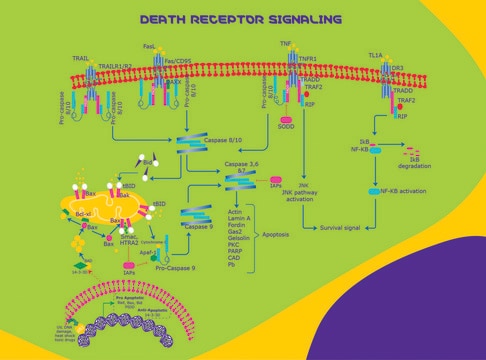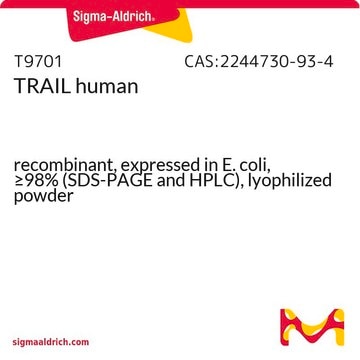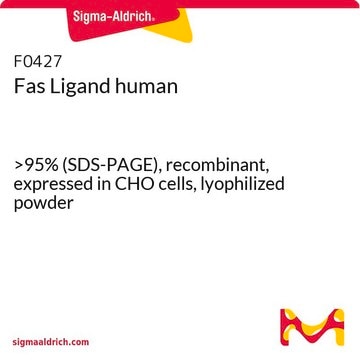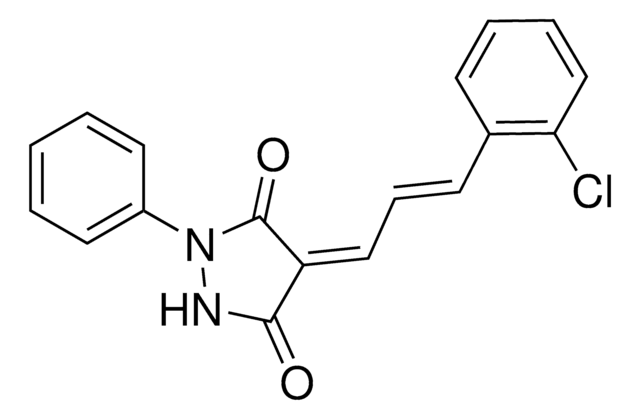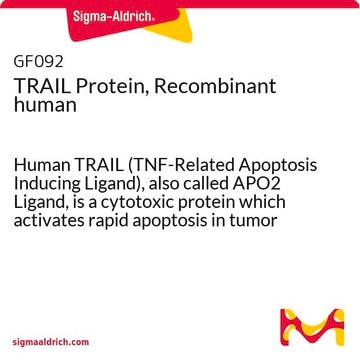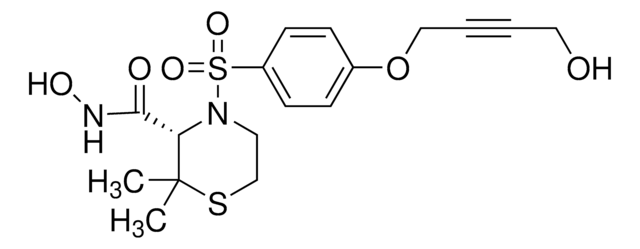SRP6238
TRAIL murine
recombinant, expressed in E. coli, ≥95% (SDS-PAGE)
Synonym(s):
Apo2 Ligand, TL2, TNF-related apoptosis-inducing Ligand, TNFSF10
Sign Into View Organizational & Contract Pricing
All Photos(1)
About This Item
UNSPSC Code:
12352200
NACRES:
NA.32
Recommended Products
biological source
rat
recombinant
expressed in E. coli
assay
≥95% (SDS-PAGE)
form
lyophilized powder
mol wt
20 kDa
packaging
pkg of 10 μg
pkg of 50 μg
impurities
<1 EU/μg endotoxin (LAL test)
UniProt accession no.
shipped in
wet ice
storage temp.
−20°C
Gene Information
mouse ... TRAIL(22035)
General description
TRAIL is a cytotoxic protein, which activates rapid apoptosis in tumor cells, but not in normal cells. TRAIL induced apoptosis is achieved through binding to two death-signaling receptors, DR4 and DR5. These receptors belong to the TNFR superfamily of transmembrane proteins and contain a cytoplasmic “death domain”, which activates the cell′s apoptotic machinery. Recombinant murine TRAIL is a 174 amino acid polypeptide (20.0 kDa), consisting of the TNF homologous portion of the extracellular domain of the full length TRAIL protein.
Physical form
Sterile filtered through a 0.2 micron filter. Lyophilized from 10 mM Sodium Phosphate, pH 7.0.
Reconstitution
Centrifuge the vial prior to opening. Reconstitute in water to a concentration of 0.1-1.0 mg/mL. Do not vortex. This solution can be stored at 2-8°C for up to 1 week. For extended storage, it is recommended to further dilute in a buffer containing a carrier protein (example 0.1% BSA) and store in working aliquots at -20°C to -80°C.
wgk_germany
WGK 1
flash_point_f
Not applicable
flash_point_c
Not applicable
Certificates of Analysis (COA)
Search for Certificates of Analysis (COA) by entering the products Lot/Batch Number. Lot and Batch Numbers can be found on a product’s label following the words ‘Lot’ or ‘Batch’.
Already Own This Product?
Find documentation for the products that you have recently purchased in the Document Library.
Katrin Högner et al.
PLoS pathogens, 9(2), e1003188-e1003188 (2013-03-08)
Influenza viruses (IV) cause pneumonia in humans with progression to lung failure and fatal outcome. Dysregulated release of cytokines including type I interferons (IFNs) has been attributed a crucial role in immune-mediated pulmonary injury during severe IV infection. Using ex
Lenka V Tamayo et al.
Biometals : an international journal on the role of metal ions in biology, biochemistry, and medicine, 29(1), 39-52 (2015-11-20)
Copper(II) complexes [Cu(H2O)2 (L1)(phen)](ClO4) (1) and [Cu(H2O)(L2)(phen)](ClO4) (2) (HL1 = naringenin; HL2 = hesperetin) were obtained, in which an anionic flavonoid ligand is attached to the metal center along with 1,10-phenanthroline (phen) as co-ligand. Complexes (1) and (2) were assayed
Kathrin Steinwede et al.
The Journal of experimental medicine, 209(11), 1937-1952 (2012-10-17)
Apoptotic death of alveolar macrophages observed during lung infection with Streptococcus pneumoniae is thought to limit overwhelming lung inflammation in response to bacterial challenge. However, the underlying apoptotic death mechanism has not been defined. Here, we examined the role of
Our team of scientists has experience in all areas of research including Life Science, Material Science, Chemical Synthesis, Chromatography, Analytical and many others.
Contact Technical Service